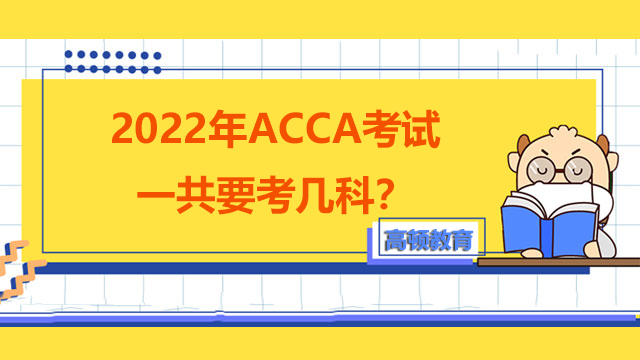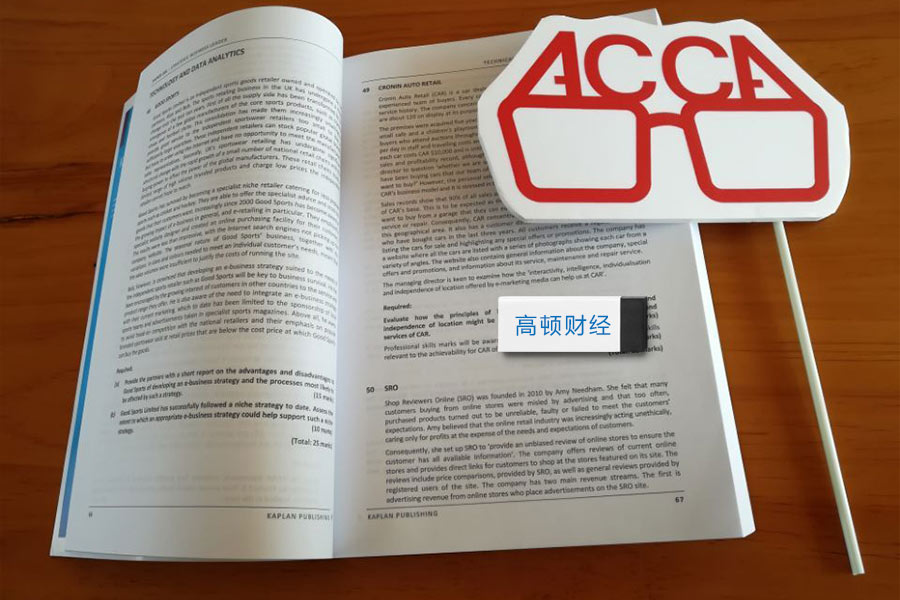2015ACCA F7财务报告考试大纲
来源:
高顿网校
2015-03-25
? ACCA 2014 All rights reserved.
Financial Reporting (F7)
December 2014 to June
2015
This syllabus and study guide is designed to help
with planning study and to provide detailed
information on what could be assessed in
any examination session.
THE STRUCTURE OF THE SYLLABUS AND
STUDY GUIDE
Relational diagram of paper with other papers
This diagram shows direct and indirect links
between this paper and other papers preceding or
following it. Some papers are directly underpinned
by other papers such as Advanced Performance
Management by Performance Management. These
links are shown as solid line arrows. Other papers
only have indirect relationships with each other
such as links existing between the accounting and
auditing papers. The links between these are shown
as dotted line arrows. This diagram indicates where
you are expected to have underpinning knowledge
and where it would be useful to review previous
learning before undertaking study.
Overall aim of the syllabus
This explains briefly the overall objective of the
paper and indicates in the broadest sense the
capabilities to be developed within the paper.
Main capabilities
This paper’s aim is broken down into several main
capabilities which divide the syllabus and study
guide into discrete sections.
Relational diagram of the main capabilities
This diagram illustrates the flows and links between
the main capabilities (sections) of the syllabus and
should be used as an aid to planning teaching and
learning in a structured way.
Syllabus rationale
This is a narrative explaining how the syllabus is
structured and how the main capabilities are linked.
The rationale also explains in further detail what the
examination intends to assess and why.
Detailed syllabus
This shows the breakdown of the main capabilities
(sections) of the syllabus into subject areas. This is
the blueprint for the detailed study guide.
Approach to examining the syllabus
This section briefly explains the structure of the
examination and how it is assessed.
Study Guide
This is the main document that students, learning
and content providers should use as the basis of
their studies, instruction and materials.
Examinations will be based on the detail of the
study guide which comprehensively identifies what
could be assessed in any examination session.
The study guide is a precise reflection and
breakdown of the syllabus. It is divided into sections
based on the main capabilities identified in the
syllabus. These sections are divided into subject
areas which relate to the sub-capabilities included
in the detailed syllabus. Subject areas are broken
down into sub-headings which describe the detailed
outcomes that could be assessed in examinations.
These outcomes are described using verbs
indicating what exams may require students to
demonstrate, and the broad intellectual level at
which these may need to be demonstrated
(*see intellectual levels below)。
INTELLECTUAL LEVELS
The syllabus is designed to progressively broaden
and deepen the knowledge, skills and professional
values demonstrated by the student on their way
through the qualification.
The specific capabilities within the detailed
syllabuses and study guides are assessed at one of
three intellectual or cognitive levels:
LevelⅠ: Knowledge and comprehension
LevelⅡ: Application and analysis
? ACCA 2014 All rights reserved.
LevelⅢ: Synthesis and evaluation
Very broadly, these intellectual levels relate to the
three cognitive levels at which the Knowledge
module, the Skills module and the Professional level
are assessed.
Each subject area in the detailed study guide
included in this document is given a 1, 2, or
3 superscript, denoting intellectual level, marked at
the end of each relevant line. This gives an
indication of the intellectual depth at which an area
could be assessed within the examination. However,
while level 1 broadly equates with the Knowledge
module, level 2 equates to the Skills module and
level 3 to the Professional level, some lower level
skills can continue to be assessed as the student
progresses through each module and level. This
reflects that at each stage of study there will be a
requirement to broaden, as well as deepen
capabilities. It is also possible that occasionally
some higher level capabilities may be assessed at
lower levels.
LEARNING HOURS AND EDUCATION
RECOGNITION
The ACCA qualification does not prescribe or
recommend any particular number of learning hours
for examinations because study and learning
patterns and styles vary greatly between people and
organisations. This also recognises the wide
diversity of personal, professional and educational
circumstances in which ACCA students find
themselves.
As a member of the International Federation of
Accountants, ACCA seeks to enhance the education
recognition of its qualification on both national and
international education frameworks, and with
educational authorities and partners globally. In
doing so, ACCA aims to ensure that its qualifications
are recognized and valued by governments,
regulatory authorities and employers across all
sectors. To this end, ACCA qualifications are
currently recognized on the education frameworks in
several countries. Please refer to your national
education framework regulator for further
information.
Each syllabus contains between 23 and 35 main
subject area headings depending on the nature of
the subject and how these areas have been broken
down.
GUIDE TO EXAM STRUCTURE
The structure of examinations varies within and
between modules and levels.
The Fundamentals level examinations contain
100% compulsory questions to encourage
candidates to study across the breadth of each
syllabus.
The Knowledge module is assessed by equivalent
two-hour paper based and computer based
examinations.
The Skills module examinations F5-F9 are all paper
based three-hour papers containing a mix of
objective and longer type questions. The Corporate
and Business Law (F4) paper is a two- hour
computer based objective test examination which is
also available as a paper based version from the
December 2014 examination session.
The Professional level papers are all three-hour
paper based examinations, all containing two
sections. Section A is compulsory, but there will be
some choice offered in Section B.
For all three hour examination papers, ACCA has
introduced 15 minutes reading and planning time.
This additional time is allowed at the beginning of
each three-hour examination to allow candidates to
read the questions and to begin planning their
answers before they start writing in their answer
books. This time should be used to ensure that all
the information and exam requirements are properly
read and understood.
During reading and planning time candidates may
only annotate their question paper. They may not
write anything in their answer booklets until told to
do so by the invigilator.
The Essentials module papers all have a Section A
containing a major case study question with all
requirements totalling 50 marks relating to this
case. Section B gives students a choice of two from
three 25 mark questions.
Section A of both the P4 and P5 Options papers
contain one 50 mark compulsory question, and
? ACCA 2014 All rights reserved.
Section B will offer a choice of two from three
questions each worth 25 marks each.
Section A of each of the P6 and P7 Options papers
contains 60 compulsory marks from two questions;
question 1 attracting 35 marks, and question 2
attracting 25 marks. Section B of both these
Options papers will offer a choice of two from three
questions, with each question attracting 20 marks.
All Professional level exams contain four
professional marks.
The pass mark for all ACCA Qualification
examination papers is 50%.
GUIDE TO EXAMINATION ASSESSMENT
ACCA reserves the right to examine anything
contained within the study guide at any examination
session. This includes knowledge, techniques,
principles, theories, and concepts as specified.
For the financial accounting, audit and assurance,
law and tax papers except where indicated
otherwise, ACCA will publish examinable
documents once a year to indicate exactly
what regulations and legislation could potentially be
assessed within identified examination sessions
For paper based examinations regulation issued or
legislation passed on or before 31st August annually,
will be examinable from 1st September of the
following year to 31st August of the year after that.
Please refer to the examinable documents for the
paper (where relevant) for further information.
Regulation issued or legislation passed in
accordance with the above dates may be
examinable even if the effective date is in the future.
The term issued or passed relates to when
regulation or legislation has been formally approved.
The term effective relates to when regulation or
legislation must be applied to an entity transactions
and business practices.
The study guide offers more detailed guidance on
the depth and level at which the examinable
documents will be examined. The study guide
should therefore be read in conjunction with the
examinable documents list.
? ACCA 2014 All rights reserved.
Syllabus
AIM
To develop knowledge and skills in understanding
and applying accounting standards and the
theoretical framework in the preparation of financial
statements of entities, including groups and how to
analyse and interpret those financial statements.
.
MAIN CAPABILITIES
On successful completion of this paper candidates
should be able to:
A Discuss and apply a conceptual and regulatory
frameworks for financial reporting
B Account for transactions in accordance with
International accounting standards
C Analyse and interpret financial statements.
D Prepare and present financial statements
for single entities and business combinations in
accordance with International accounting
standards
RELATIONAL DIAGRAM OF MAIN CAPABILITIES
FR
(F7)
CR (P2)
FA (F3)
CL (F4) AA (F8)
BA (P3)
The conceptual and regulatory framework
for financial reporting
(A)
Accounting for transactions in financial statements (B)
Preparation of financial statements (D)
Analysing
and
interpreting
financial
statements
(C)
? ACCA 2014 All rights reserved.
RATIONALE
The financial reporting syllabus assumes knowledge
acquired in Paper F3, Financial Accounting, and
develops and applies this further and in greater
depth.
The syllabus begins with the conceptual framework
of accounting with reference to the qualitative
characteristics of useful information and the
fundamental bases of accounting introduced in the
Paper F3 syllabus within the Knowledge module. It
then moves into a detailed examination of the
regulatory framework of accounting and how this
informs the standard setting process.
The main areas of the syllabus cover the reporting of
financial information for single companies and for
groups in accordance with generally accepted
accounting principles and relevant accounting
standards.
Finally, the syllabus covers the analysis and
interpretation of information from financial reports.
? ACCA 2014 All rights reserved.
DETAILED SYLLABUS
A The conceptual and regulatory framework for
financial reporting
1. The need for a conceptual framework and the
characteristics of useful information
2. Recognition and measurement
3. Specialised, not-for-profit, and public sector
entities
4. Regulatory framework
5. The concepts and principles of groups and
consolidated financial statements
B Accounting for transactions in financial
statements
1. Tangible non-current assets
2. Intangible assets
3. Impairment of assets
4. Inventory and biological assets
5. Financial instruments
6. Leasing
7. Provisions and events after the reporting period
8. Taxation
9. Reporting financial performance
10. Revenue
11. Government grants
C Analysing and interpreting financial
statements
1. Limitations of financial statements
2. Calculation and interpretation of accounting
ratios and trends to address users’ and
stakeholders’ needs
3. Limitations of interpretation techniques
4. Specialised, not-for-profit, and public sector
entities
D Preparation of financial statements
1. Preparation of single entity financial statements
2. Preparation of consolidated financial
statements including an associate
? ACCA 2014 All rights reserved.
APPROACH TO EXAMINING THE SYLLABUS
The syllabus is assessed by a three-hour paperbased
examination.
All questions are compulsory. It will contain both
computational and discursive elements.
Some questions will adopt a scenario/case study
approach.
Section A of the exam comprises 20 multiple choice
questions of 2 marks each.
Section B of the exam comprises two 15 mark
questions and one 30 mark question.
The 30 mark question will examine the preparation
of financial statements for either a single entity or a
group. The section A question and the other
questions in section B can cover any areas of the
syllabus.
An individual question may often involve elements
that relate to different subject areas of the syllabus.
For example the preparation of an entity’s financial
statements could include matters relating to several
accounting standards.
Questions may ask candidates to comment on the
appropriateness or acceptability of management’s
opinion or chosen accounting treatment. An
understanding of accounting principles and concepts
and how these are applied to practical examples will
be tested.
Questions on topic areas that are also included in
Paper F3 will be examined at an appropriately
greater depth in this paper.
Candidates will be expected to have an appreciation
of the need for specified accounting standards and
why they have been issued. For detailed or complex
standards, candidates need to be aware of their
principles and key elements.
? ACCA 2014 All rights reserved.
Study Guide
A THE CONCEPTUAL AND REGULATORY
FRAMEWORK FOR FINANCIAL REPORTING
1. The need for a conceptual framework and the
characteristics of useful information
a) Describe what is meant by a conceptual
framework of accounting.[2]
b) Discuss whether a conceptual framework is
necessary and what an alternative system
might be.[2]
c) Discuss what is meant by relevance and
faithful representation and describe the
qualities that enhance these characteristics.[2]
d) Discuss whether faithful representation
constitutes more than compliance with
accounting standards.[1]
e) Discuss what is meant by understandability
and verifiability in relation to the provision of
financial information.[2]
f) Discuss the importance of comparability and
timeliness to users of financial statements.[2]
g) Discuss the principle of comparability in
accounting for changes its accounting
policies.[2]
2. Recognition and measurement
a) Define what is meant by ‘recognition’ in
financial statements and discuss the
recognition criteria.[2]
b) Apply the recognition criteria to: [2]
i) assets and liabilities.
ii) income and expenses
c) Explain the following measures and compute
amounts using: [2]
i) historical cost
ii) fair value/current cost
iii) net realisable value
iv) present value of future cash flows.
d) Discuss the advantages and disadvantages of
the use of historical cost accounting.
e) Discuss whether the use of current value
accounting overcomes the problems of
historical cost accounting.[2]
f) Describe the concept of financial and physical
capital maintenance and how this affects the
determination of profits.[1]
3. Specialised, not-for-profit and public sector
entities
a) Distinguish between the primary aims of notfor
profit and public sector entities and those of
profit oriented entities.[1]
b) Discuss the extent to which International
Financial Reporting Standards (IFRSs) are
relevant to specialised, not-for-profit and public
sector entities.[1]
4. Regulatory framework
a) Explain why a regulatory framework is needed
also including the advantages and
disadvantages of IFRS over a national
regulatory framework.[2]
b) Explain why accounting standards on their own
are not a complete regulatory framework.[2]
c) Distinguish between a principles based and a
rules based framework and discuss whether
they can be complementary.[1]
d) Describe the IASB’s Standard setting process
including revisions to and interpretations of
Standards.[2]
e) Explain the relationship of national standard
setters to the IASB in respect of the standard
setting process.[2]
5. The concepts and principles of groups and
consolidated financial statements
a) Describe the concept of a group as a single
economic unit.[2]
b) Explain and apply the definition of a subsidiary
within relevant accounting standards.[2]
c) Identify and outline using accounting standards
the circumstances in which a group is required
? ACCA 2014 All rights reserved.
to prepare consolidated financial statements as
required by applicable accounting standards
and other regulation. [2]
d) Describe the circumstances when a group may
claim exemption from the preparation of
consolidated financial statements.[2]
e) Explain why directors may not wish to
consolidate a subsidiary and when this is
permitted by accounting standards and other
applicable regulation.[2]
f) Explain the need for using coterminous year
ends and uniform accounting polices when
preparing consolidated financial statements.[2]
g) Explain why it is necessary to eliminate intra
group transactions. [2]
h) Explain the objective of consolidated financial
statements. [2]
i) Explain why it is necessary to use fair values
for the consideration for an investment in a
subsidiary together with the fair values of a
subsidiary’s identifiable assets and liabilities
when preparing consolidated financial
statements. [2]
j) Define an associate and explain the principles
and reasoning for the use of equity accounting.
[2]
B ACCOUNTING FOR TRANSACTIONS IN
FINANCIAL STATEMENTS
1. Tangible non-current assets
a) Define and compute the initial measurement of
a non-current (including a self-constructed and
borrowing costs) asset.[2]
b) Identify subsequent expenditure that may be
capitalised, distinguishing between capital and
revenue items.[2]
c) Discuss the requirements of relevant
accounting standards in relation to the
revaluation of non-current assets.[2]
d) Account for revaluation and disposal gains and
losses for non-current assets.[2]
e) Compute depreciation based on the cost and
revaluation models and on assets that have
two or more significant parts (complex
assets)。[2]
f) Discuss why the treatment of investment
properties should differ from other properties.[2]
g) Apply the requirements of relevant accounting
standards for investment property.[2]
2. Intangible non-current assets
a) Discuss the nature and accounting treatment of
internally generated and purchased
intangibles.[2]
b) Distinguish between goodwill and other
intangible assets.[2]
c) Describe the criteria for the initial recognition
and measurement of intangible assets.[2]
d) Describe the subsequent accounting treatment,
including the principle of impairment tests in
relation to goodwill.[2]
e) Indicate why the value of purchase
consideration for an investment may be less
than the value of the acquired identifiable net
assets and how the difference should be
accounted for.[2]
f) Describe and apply the requirements of
relevant accounting standards to research and
development expenditure.[2]
3. Impairment of assets
a) Define an impairment loss.[2]
b) Identify the circumstances that may indicate
impairments to assets.[2]
c) Describe what is meant by a cash generating
unit.[2]
d) State the basis on which impairment losses
should be allocated, and allocate an
impairment loss to the assets of a cash
generating unit.[2]
? ACCA 2014 All rights reserved.
4. Inventory and biological assets
a) Describe and apply the principles of inventory
valuation.[2]
b) Apply the requirements of relevant accounting
standards for biological assets.[2]
5 Financial instruments
a) Explain the need for an accounting standard on
financial instruments.[1]
b) Define financial instruments in terms of
financial assets and financial liabilities.[1]
c) Indicate for the following categories of financial
instruments how they should be measured and
how any gains and losses from subsequent
measurement should be treated in the financial
statements: [1]
i) amortised cost
ii) fair value ( including option to elect to
present gains and losses on
equity instruments in other
comprehensive income) [2]
d) Distinguish between debt and equity capital.[2]
e) Apply the requirements of relevant accounting
standards to the issue and finance costs of: [2]
i) equity
ii) redeemable preference shares and debt
instruments with no conversion rights
(principle of amortised cost)
iii) convertible debt
6. Leasing
a) Explain why recording the legal form of a
finance lease can be misleading to users
(referring to the commercial substance of such
leases)。[2]
b) Describe and apply the method of determining
a lease type (i.e. an operating or finance
lease)。[2]
c) Discuss the effect on the financial statements
of a finance lease being incorrectly treated as
an operating lease.[2]
d) Account for assets financed by finance leases
in the records of the lessee.[2]
e) Account for operating leases in the records of
the lessee.[2]
7. Provisions and events after the reporting period
a) Explain why an accounting standard on
provisions is necessary.[2]
b) Distinguish between legal and constructive
obligations.[2]
c) State when provisions may and may not be
made and demonstrate how they should be
accounted for.[2]
d) Explain how provisions should be measured.[1]
e) Define contingent assets and liabilities and
describe their accounting treatment.[2]
f) Identify and account for: [2]
i) warranties/guarantees
ii) onerous contracts
iii) environmental and similar provisions
iv) provisions for future repairs or
refurbishments.
g) Events after the reporting period
i) distinguish between and account for
adjusting and non-adjusting events after the
reporting period [2]
ii) Identify items requiring separate disclosure,
including their accounting treatment and
required disclosures[2]
8. Taxation
a) Account for current taxation in accordance with
relevant accounting standards.[2]
b) Explain the effect of taxable temporary
differences on accounting and taxable profits.[2]
c) Compute and record deferred tax amounts in
the financial statements.[2]
? ACCA 2014 All rights reserved.
9. Reporting financial performance
a) Discuss the importance of identifying and
reporting the results of discontinued
operations.[2]
b) Define and account for non-current assets held
for sale and discontinued operations.[2]
c) Indicate the circumstances where separate
disclosure of material items of income and
expense is required.[2]
d) Account for changes in accounting estimates,
changes in accounting policy and correction of
prior period errors
e) Earnings per share (eps)
i) calculate the eps in accordance with
relevant accounting standards (dealing with
bonus issues, full market value issues and
rights issues) [2]
ii) explain the relevance of the diluted eps and
calculate the diluted eps involving
convertible debt and share options
(warrants) [2]
10. Revenue
a) Apply the principle of substance over form to
the recognition of revenue.[2]
b) Explain the importance of recording the
commercial substance rather than the legal
form of transactions – give examples where
recording the legal form of transactions may be
misleading.[2]
c) Describe the features which may indicate that
the substance of transactions differs from their
legal form.[2]
d) Apply the principle of substance over form to
the recognition and derecognition of assets and
liabilities.[2]
e) Recognise the substance of transactions in
general, and specifically account for the
following types of transaction: [2]
i) goods sold on sale or return/consignment
inventory
ii) sale and repurchase/leaseback agreements
iii) factoring of receivables.
f) Define a construction contract and discuss the
role of accounting concepts in the recognition
of profit.[2]
g) Describe the acceptable methods of
determining the stage (percentage) of
completion of a contract.[2]
h) Prepare financial statement extracts for
construction contracts.[2]
11. Government grants
a) Apply the provisions of relevant accounting
standards in relation to accounting for
government grants.[2]
C ANALYSING AND INTERPRETING FINANCIAL
STATEMENTS
1. Limitations of financial statements
a) Indicate the problems of using historic
information to predict future performance and
trends.[2]
b) Discuss how financial statements may be
manipulated to produce a desired effect
(creative accounting, window dressing)。[2]
c) Explain why figures in a statement of financial
position may not be representative of average
values throughout the period for example, due
to: [2]
i) seasonal trading
ii) major asset acquisitions near the end of the
accounting period.
2 Calculation and interpretation of accounting
ratios and trends to address users’ and
stakeholders’ needs
a) Define and compute relevant financial ratios.[2]
b) Explain what aspects of performance specific
ratios are intended to assess.[2]
c) Analyse and interpret ratios to give an
assessment of an entity’s performance and
financial position in comparison with: [2]
i) an entity’s previous period’s financial
statements
? ACCA 2014 All rights reserved.
ii) another similar entity for the same reporting
period
iii) industry average ratios.
d) Interpret an entity’s financial statements to give
advice from the perspectives of different
stakeholders.[2]
e) Discuss how the interpretation of current value
based financial statements would differ from
those using historical cost based accounts.[1]
3. Limitations of interpretation techniques
a) Discuss the limitations in the use of ratio
analysis for assessing corporate performance.[2]
b) Discuss the effect that changes in accounting
policies or the use of different accounting
polices between entities can have on the ability
to interpret performance.[2]
c) Indicate other information, including nonfinancial
information, that may be of relevance
to the assessment of an entity’s performance.[1]
d) Compare the usefulness of cash flow
information with that of a statement of profit or
loss or a statement of profit or loss and other
comprehensive income.[2]
e) Interpret a statement of cash flows (together
with other financial information) to assess the
performance and financial position of an entity.[2]
f) i) explain why the trend of eps may be a
more accurate indicator of performance
than a company’s profit trend and the
importance of eps as a stock market
indicator [2]
ii) discuss the limitations of using eps as a
performance measure.[3]
4. Specialised, not-for-profit and public sector
entities
a) Discuss the different approaches that may be
required when assessing the performance of
specialised, not-for-profit and public sector
organisations.[1]
D PREPARATION OF FINANCIAL STATEMENTS
1. Preparation of single entity financial statements
a) Prepare an entity’s statement of financial
position and statement of profit or loss and
other comprehensive income in accordance
with the structure prescribed within IFRS and
content drawing on accounting treatments as
identified within A, B and C.[2]
b) Prepare and explain the contents and purpose
of the statement of changes in equity.[2]
c) Prepare a statement of cash flows for a single
entity (not a group) in accordance with relevant
accounting standards using the direct and the
indirect method .[2]
2. Preparation of consolidated financial
statements including an associate
a) Prepare a consolidated statement of financial
position for a simple group (parent and one
subsidiary and associate) dealing with pre and
post acquisition profits, non-controlling
interests and consolidated goodwill.[2]
b) Prepare a consolidated statement of profit or
loss and consolidated statement of profit or
loss and other comprehensive income for a
simple group dealing with an acquisition in the
period and non-controlling interest.[2]
c) Explain and account for other reserves (e.g.
share premium and revaluation reserves)。[1]
d) Account for the effects in the financial
statements of intra-group trading.[2]
e) Account for the effects of fair value
adjustments (including their effect on
consolidated goodwill) to: [2]
i) depreciating and non-depreciating noncurrent
assets
ii) inventory
iii) monetary liabilities
iv) assets and liabilities not included in the
subsidiary’s own statement of financial
position, including contingent assets and
liabilities
? ACCA 2014 All rights reserved.
f) Account for goodwill impairment.[2]
g) Describe and apply the required accounting
treatment of consolidated goodwill.[2]
? ACCA 2014 All rights reserved.
SUMMARY OF CHANGES TO F7
RATIONALE FOR CHANGES
ACCA periodically reviews its qualification syllabuses so that they fully meet the needs of stakeholders such as
employers, students, regulatory and advisory bodies and learning providers.
Note of significant changes to study guide Paper F7
The main areas to be added or deleted from the syllabus from that date are shown in Table 1 and 2 below:
Table 1 – Additions to F7
B4(b) Apply the requirements of relevant accounting standards for
biological assets
The principles of IAS 41 Agriculture
have been introduced to the F7
syllabus
Table 2 – Deletions to F7
There have been some minor deletions to the study guide for the exam year commencing 1 September 2014.
These have been made to remove outcomes that overlap with others within F7 or with outcomes fully examined
in paper F3.
Ref in prior year
study guide
A1c) Indicate the circumstances and required
disclosures where a ‘true and fair’ override may
apply
B2a) Describe the structure and objectives of the
IFRS Foundation, the International Accounting
Standards Board (IASB), the IFRS Advisory
Council (IFRS AC) and the IFRS
Interpretations Committee (IFRS IC)。[2]
B9b) Record entries relating to income tax in the
accounting records
E1 c) Recognise how related party relationships
have the potential to mislead users
This has been removed to clarify
that no knowledge of disclosure of
related parties is required.
Table 2 – Changes to the structure of the syllabus of F7
There have been changes to how certain outcomes are grouped into sections within the syllabus.
The outline of these changes are outlined below:
? The conceptual and regulatory framework outcomes have been combined into one section. This section,
A, also now includes the concepts relating to group accounting
? The outcomes relating to substance over form, revenue and construction contracts have been grouped
together in subject area B10
? The outcome relating to government grants (previously grouped with the non-current assets outcomes)
has been separately classified as subject area B11 to clarify that both revenue based and capital grants
can be examined.
? Preparation of financial statements of both single entities and groups are now combined within section
D.
高顿网校温馨提示: 通过ACCA考试实属不易,首先要有执着的精神,其次是不断勤奋的学习,高顿网校为大家提供ACCA题库免费做题,希望助大家一臂之力,查看详情》
| ACCA网络课程 | 课程专业名称 | 讲师 | 试听 |
 85%的人正在学习该课程 85%的人正在学习该课程 | ACCA 全维度网课体验课程 实景课堂与独立录制 覆盖所有知识点,根据学习计划推进学习进度 | 高顿名师 |  |
 70%的人正在学习该课程 70%的人正在学习该课程 | ACCA网课全科卡(8.2折) 为零基础刚开始学习ACCA的学员特别定制 | 高顿名师 |  |
精彩推荐:
版权声明:本条内容自发布之日起,有效期为一个月。凡本网站注明“来源高顿教育”或“来源高顿网校”或“来源高顿”的所有作品,均为本网站合法拥有版权的作品,未经本网站授权,任何媒体、网站、个人不得转载、链接、转帖或以其他方式使用。
经本网站合法授权的,应在授权范围内使用,且使用时必须注明“来源高顿教育”或“来源高顿网校”或“来源高顿”,并不得对作品中出现的“高顿”字样进行删减、替换等。违反上述声明者,本网站将依法追究其法律责任。
本网站的部分资料转载自互联网,均尽力标明作者和出处。本网站转载的目的在于传递更多信息,并不意味着赞同其观点或证实其描述,本网站不对其真实性负责。
如您认为本网站刊载作品涉及版权等问题,请与本网站联系(邮箱fawu@gaodun.com,电话:021-31587497),本网站核实确认后会尽快予以处理。
点一下领资料
【整理版】ACCA各科目历年真题
真题高频考点,刷题全靠这份资料
下载合集
acca全科学习思维导图
梳理核心考点,一图看懂全部章节
下载合集
2023年acca考纲解析
覆盖科目重难点,备考按照计划走
下载合集
acca备考 热门问题解答
- acca考试怎么搭配科目?
-
建议优先选择相关联的科目进行搭配报考,这样可以提高备考效率,减轻备考压力,1、F1-F4:为随时机考科目,难度较低,这里可以自行随意选择考试顺序。2、F5-F9:如果你的工作的和财务会计或者审计有关、或者你比较擅长财务和审计的话,推荐先考F7和F8。你可以选择一起考ACCA考试科目F7和F8或者先考F7(8)再考F8(7),这就要取决你一次想考几门。3、P阶段:选修科目中,建议企业首选AFM!第二部分科目进行选择,如果AA和SBR掌握学生更好,可以通过选择AAA,如果SBL掌握的好,可以自己选择APM。
- acca一共几门几年考完?
-
acca一共有15门考试科目,其中有必修科目和选修科目,考生需要考完13门科目才能拿下证书。
- acca一年考几次?
-
acca一年有4次考试,分别是3月、6月、9月和12月,分季机考科目是采取的这类四个考季的模式,而随时机考则是没有这方面的时间规定限制,可以随报随考。
- acca的含金量如何?
-
ACCA证书的含金量是比较高的,从就业、能力提升、全球认可等角度来说,都是比较有优势的证书,其含金量主要表现在以下几个方面:1、国际化,认可度高;2、岗位多,就业前景好;3、缺口大,人才激励。
严选名师 全流程服务
其他人还搜了
热门推荐
-
长春ACCA培训课程,高顿ACCA推荐吗? 2023-06-19
-
【考试重点】acca2023年9月SBL变化详解,速进了解! 2023-06-19
-
acca《PM业绩管理》考试大纲变化,2023年9月起变动情况一览! 2023-04-26
-
2023年6月acca考试哪些科目考纲有变化?赶快来看! 2023-04-25
-
ACCA2023年考试重点介绍,新手看过来! 2023-03-29
-
9月acca考试考纲变了吗?这些科目变动你要了解! 2023-03-10
-
acca考纲每次变化大吗?2023年9月起变动0%-12%! 2023-03-10
-
ACCA科目名称英文一览 2022-05-23
-
ACCA都考什么内容? 2022-05-20
-
ACCA课程内容介绍 2022-05-12
-
2022年ACCA考试一共要考几科? 2022-05-11
-
ACCA的考试内容都有什么? 2022-05-10
-
ACCA官网操作 | 如何鉴别自己是FIA还是ACCA&考试报名退考流程 2021-06-30
-
2020年最新ACCA考试大纲哪里找? 2020-03-04
-
2014年12月ACCA考试改动方向及难度变化,资阳考生必看! 2019-01-04
-
2014年12月ACCA考试改动方向及难度变化,资阳考生必看! 2019-01-04
-
2018年ACCA考试新旧考纲变化详解 2019-01-02
-
12月ACCA考试前瞻:2017年9月ACCA F7考试分析 2017-11-21
-
ACCA考试F8考试大纲变化解析 2017-04-19
-
ACCA考试F7考纲变化分析 2017-01-04
-
acca福建厦门考点i831在哪里 2016-12-19
-
拉萨有没有比较好的ACCA培训机构? 2016-06-29
-
石嘴山有没有比较好的ACCA培训机构? 2016-06-29
-
嘉峪关有没有比较好的ACCA培训机构? 2016-06-29
-
吐鲁番有没有比较好的ACCA培训机构? 2016-06-29
-
武夷山有没有比较好的ACCA培训机构? 2016-06-29
-
保山有没有比较好的ACCA培训机构? 2016-06-22
-
果洛有没有比较好的ACCA培训机构? 2016-06-22
-
临夏有没有比较好的ACCA培训机构? 2016-06-22
-
喀什有没有比较好的ACCA培训机构? 2016-06-22
 更多服务
更多服务





























